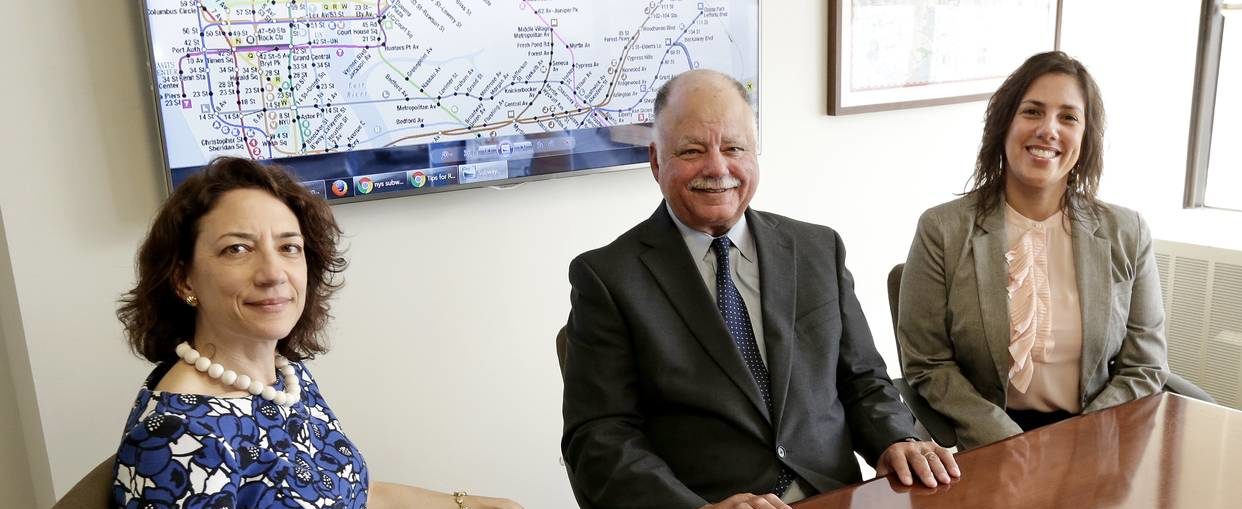
From left: Polly Trottenberg, David Jones, and Veronica Vanterpool | Photo Credit: WSJ
This post launches a new blog series by TransitCenter program associate Julia Ehrman about diversity, representation, and equity of opportunity in the transit workforce.Though we’ve often been critical of NYC Mayor Bill de Blasio’s transportation policy choices, our disagreements do not extend to his MTA board appointments. De Blasio tripled representation of both women and people of color on the MTA board with his appointments of Polly Trottenberg, Veronica Vanterpool, and David Jones. He also attempted to place City Councilmember Ydanis Rodriguez on the board, but was thwarted by the NY State Senate. Fifty-two percent of the MTA’s service area residents are women, and fifty-six percent are people of color (In New York City – where the vast majority of riders live and work – sixty-eight percent are people of color), but eighteen of the transit agency’s twenty-three board members – seventy-eight percent – are white men.
Though the mayor appoints only an MTA board minority of four, de Blasio’s roster of new transit leaders has helped shift public debate and MTA policy on key issues facing vulnerable New Yorkers. Trottenberg and Vanterpool bring transportation policy experience from two different points of view – as a longtime federal transportation policymaker and transportation advocate, respectively, while Jones heads an organization that advocates for low income New Yorkers. The city delegation on the board has become an ally to disability advocates in their campaign for a much more ambitious and inclusive MTA approach to accessibility, helping to call the agency’s Enhanced Station Initiative (ESI) into question. Jones has spoken publicly against fare evasion arrests, and voted against fare increases.
Transit boards don’t make specific planning or operational decisions, but they play an essential role in shaping the broad policies, values and criteria that guide these decisions. Boards can call on electeds to launch bus network redesigns, set fare policy, and can even fire the boss. And Board members with backgrounds and life experiences that reflect ridership and a variety of viewpoints will better understand what matters most to people who use transit.
Here we take a look at who is governing American transit agencies, and how well they reflect transit riders and the residents of their service areas. We begin with three large agencies in disparate parts of the country: Atlanta, Boston, and Portland OR. Using American Community Survey estimates for 2016, we compared the composition of the agency board to the transit service area population by race and sex.
ATLANTA/ MARTA
The Metropolitan Atlanta Regional Transportation Authority (MARTA) serves the Atlanta region in three counties: Fulton, Dekalb, and Clayton. MARTA operates buses, rail, and paratransit, and carries over 144 million trips per year. Its governing board is composed of 15 members appointed to four year terms by the Mayor of Atlanta (3), the Dekalb County Commission (4), the Fulton County Commission (3), the Clayton County Commission (2), and the governor (1). The Commissioner of the Georgia Department of Transportation and the Executive Director of the Georgia Regional Transportation Authority serve as permanent voting members as a function of their positions.
At MARTA, six of fifteen, or forty percent of board members are people of color. This an unusually high rate among U.S. agency boards, but it is less than half the rate of Atlanta’s transit riders. White people are also overrepresented compared to the general population in MARTA’s service area, where sixty-eight percent of people are of color.
 MARTA looks worse when it comes to representation by sex. Just three board members, or twenty percent, are women. Half of all transit riders in Atlanta are women.
MARTA looks worse when it comes to representation by sex. Just three board members, or twenty percent, are women. Half of all transit riders in Atlanta are women.

BOSTON/ MBTA
The Massachusetts Bay Transportation Authority (MBTA, or “the T”) operates buses and urban rail in greater Boston area and manages contracts for commuter rail, ferry service and paratransit in its service area. It carries over 417 million trips per year. The commuter rail network covers a vast area of Eastern Massachusetts and includes many low-density suburbs. But the majority of transit riders and neighborhoods eligible for high-frequency service fall in fourteen core municipalities, which we used for this analysis.* The MBTA is governed by two boards of directors: the eleven member board of the Massachusetts Department of Transportation (MassDOT) and the five member Fiscal and Management Control Board (FMCB), which was convened by Governor Baker following a service crisis during a winter storm in 2015. The MassDOT board oversees all transportation programs state-wide. The FCMB meets weekly to closely oversee MBTA operations and management. All board members are appointed by the governor and three members serve on both boards.
*fourteen core municipalities: Boston, Chelsea, Revere, Malden, Medford, Lynn, Cambridge, Somerville, Watertown, Arlington, Belmont, Brookline, Newton, Quincy.
Just two of thirteen total board members are people of color. One serves on both boards. This board member is also the only woman on the Fiscal Management and Control Board, and one of four women on the combined board.

 Portland OR/ TRI-MET
Portland OR/ TRI-MET
The Tri-County Metropolitan District of Oregon (Tri-Met) operates buses, rail, and paratransit in the Portland region spanning Multnomah, Clackamas, and Washington Counties in Oregon. It carries over 114 million trips per year. The governing board is composed of seven members who are appointed by the Governor to represent geographic districts, where they are required to reside. Board members serve four-year terms.
While the Tri-Met board today is fairly representative by race, it is still very imbalanced by sex. In recent days, Oregon Governor Kate Brown has nominated three new board members who are all people of color (one woman and two men) who might be approved as soon as May 22 of this year. They would replace two white members and one black member. A spokesperson told the Oregonian the governor believes it is important to bring “new and diverse voices” to the Oregon Transportation Commission and TriMet’s board.


What would change if more diverse voices were at transit decision making tables, shaping policy and investment? If more women were at the table, we might hear more about the need for service in off-peak hours to accommodate service and domestic work. We might learn that free transfers are completely essential for the multi-leg trips that work, school commuting, and errands require. We might prioritize lighting, visibility, and real-time information at bus stops to help improve safety. If more people of color were at the table, we might hear stronger challenges to expensive new rail projects that tilt the scales away from investment in bus service and amenities in communities of color where riders live. We might have a more comprehensive conversation about policing on transit, and what “safety” means in practice. If more people from the disabled community were on transit boards, their colleagues might grasp the gravity of inaccessibility and prioritize requisite changes.
Personal experience is not the only path to empathy. However, transit policy should be based on facts about rider experience and needs. Making transit boards more representative of how transit systems and cities are experienced is a simple and rapid way to open doors to policy reform.
 On the Brink: Will WMATA’s Progress Be Erased by 2024?
On the Brink: Will WMATA’s Progress Be Erased by 2024?
The experience of being a WMATA rider has substantially improved over the last 18 months, thanks to changes the agency has made like adding off-peak service and simplifying fares. Things are about to get even better with the launch of all-door boarding later this fall, overnight bus service on some lines starting in December, and an ambitious plan to redesign the Metrobus network. But all of this could go away by July 1, 2024.
Read More New TransitCenter Report: To Solve Workforce Challenges Once and For All, Transit Agencies Must Put People First
New TransitCenter Report: To Solve Workforce Challenges Once and For All, Transit Agencies Must Put People First
TransitCenter’s new report, “People First” examines the current challenges facing public sector human resources that limit hiring and retention, and outlines potential solutions to rethink this critical agency function.
Read More